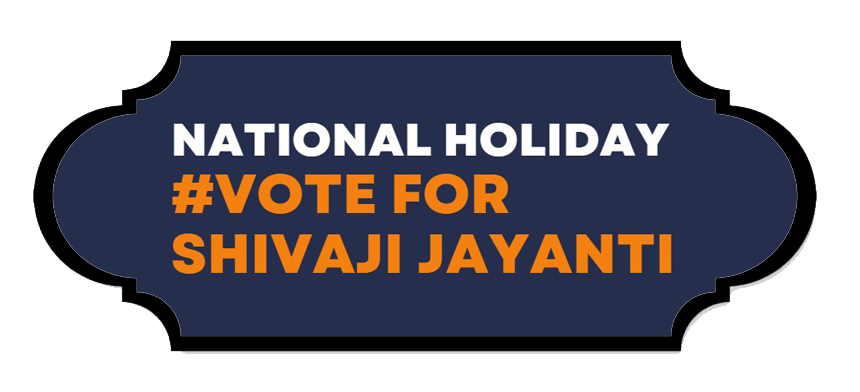
Shivaji Shahaji Bhonsale (19 February 1630 – 3 April 1680) is the Great Indian ruler and a member of the Bhonsle Dynasty.
Shivaji Maharaj died in 1680 at Raigad Fort, leaving a legacy of valor and unity.
Shivaji Maharaj’s father was Shahaji Bhonsle.
Shivaji ruled his domain for six years, through a cabinet of eight ministers.
INTRODUCTION
Shivaji (Shivaji Shahaji Bhonsale; 19 February 1630 – 3 April 1680) was an Indian ruler and a member of the Bhonsle Maratha clan. Shivaji established his independent kingdom from the declining Adilshahi Sultanate of Bijapur, laying the foundation of the Maratha Empire. In 1674, he formally crowned himself Chhatrapati at Raigad Fort. Sree Chhatrapati Shivaji Maharaj Jayanti has been celebrated in India for over 150 years, observed by millions nationwide.
His legacy holds immense significance in Indian history, and the entire nation should commemorate his Jayanti. Designating February 19th (Sree Chhatrapati Shivaji Maharaj Jayanti) as a National Holiday pays tribute to his contributions to the nation.
WHY WE CELEBRATE CHHATRAPATI SHIVAJI MAHARAJ'S BIRTH ANNIVERSARY?
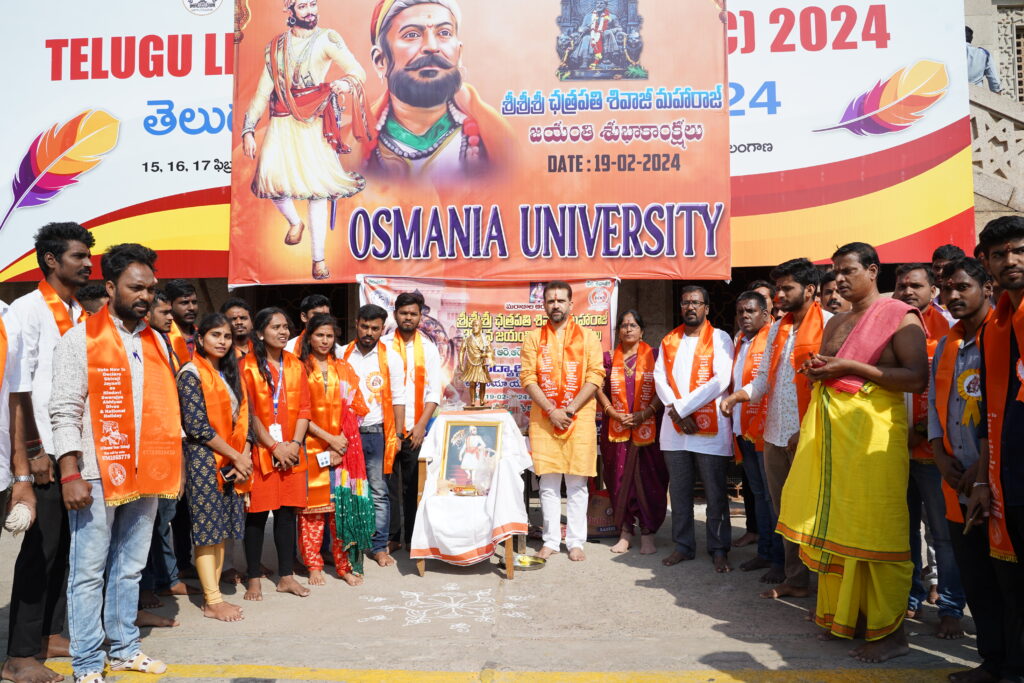
Chhatrapati Shivaji Maharaj navigated alliances and conflicts with Mughals, Sultanates, and European powers. His military expanded the Maratha sphere, capturing forts, and establishing a navy. Shivaji Maharaj established a competent and progressive civil administration with well-structured administrative institutions. Shivaji revitalized ancient Hindu political traditions and court conventions, advocating for Marathi and Sanskrit languages in administration, replacing Persian. His administration and armed forces embraced people of all castes and religions, including Muslims and Europeans, reflecting his chivalrous treatment of women.
Shivaji Maharaj’s legacy varied by observer and period. However, his importance grew significantly during the Indian independence movement. Consequently, nationalists revered him as a hero and proto-nationalist. Therefore, declaring Shivaji Jayanti a national holiday would honor his contributions. Furthermore, he treated women and all castes with immense respect. He notably included diverse groups in his administration and forces.
EARLY LIFE OF SHIVAJI (BIRTH OF CHHATRAPATI SHIVAJI MAHARAJ)
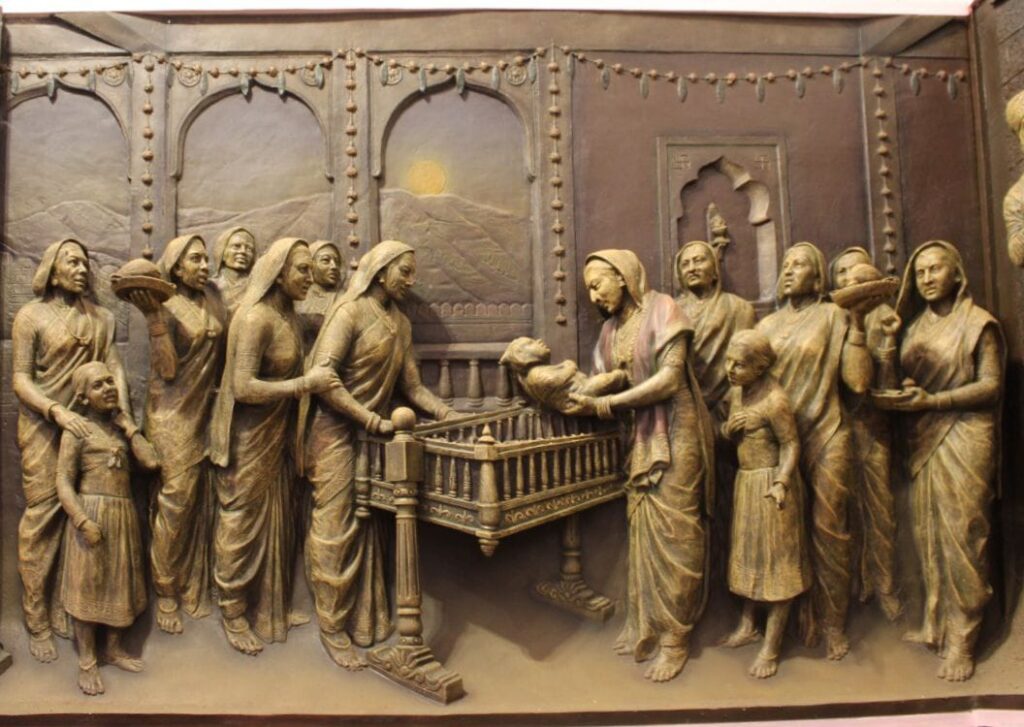
Chhatrapati Shivaji Maharaj was born in the hill fort of Shivneri, near the city of Junnar, which is in Pune. Maharashtra designates February 19 as Shivaji Maharaj Jayanti. A local deity, the goddess Shivai Devi, inspired Shivaji’s name. Shivrai Jayanti has been celebrated in India for over 150 years, observed by millions nationwide.
He hailed from the Bhonsle clan of the Maratha family. Specifically, his father, Shahaji Bhonsle, served as a Maratha general for the Deccan Sultanate. Additionally, his mother Jijabai was the daughter of Lakhuji Jadhavrao, a prominent Mughal-aligned Sardar. Furthermore, Shivaji’s paternal grandfather Maloji (1552–1597) was a prominent general of the Ahmadnagar Sultanate. For his service, Maloji became “Raja” and gained control over Pune and nearby regions. Moreover, he was granted Fort Shivneri as the family’s residence.
During Sree Chhatrapati Shivaji Maharaj Jayanti, the Deccan was under the rule of three Islamic sultanates: Bijapur, Ahmednagar, and Golkonda. Shahaji shifted allegiance among regional powers, retaining Pune’s jagir and a small army.
ADMINISTRATION OF SHIVAJI MAHARAJ
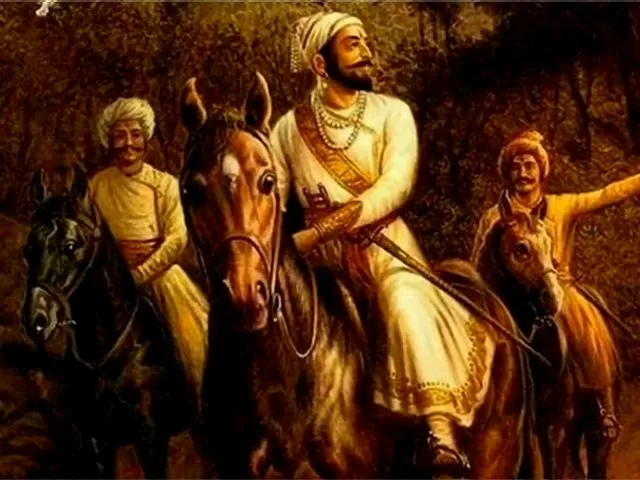
Shivaji Maharaj’s administration was efficient and progressive. It featured a well-organized government led by the Chhatrapati and an eight-member council, including the Peshwa and Senapati. He used the Ryotwari method for direct tax collection based on land productivity. Additionally, he maintained a strong military with a standing army, navy, and guerrilla tactics, supported by strategically placed forts. Local administration involved village Panchayats and officials like Deshmukhs. Shivaji promoted religious tolerance by integrating Muslims into his administration. He also encouraged trade, implemented fair taxes, and invested in infrastructure and water management. Additionally, he supported arts and culture, particularly the Marathi language. His administration laid a solid foundation for the Maratha Empire’s strength and longevity.
In 1636, the Adil Shahi sultanate of Bijapur invaded the kingdoms to its south. The sultanate had recently become a tributary state of the Mughal Empire. Shahaji, a chieftain in the Maratha uplands, sought rewards of jagir land in conquered territories. He aimed to collect taxes on them as an annuity. Shahaji rebelled after a brief stint in Mughal service. His campaigns against the Mughals, backed by Bijapur, mostly failed. He was constantly pursued by the Mughal army, and Shivaji and his mother Jijabai had to move from fort to fort.
INDEPENDENT AND GENERALSHIP OF SHIVAJI MAHARAJ
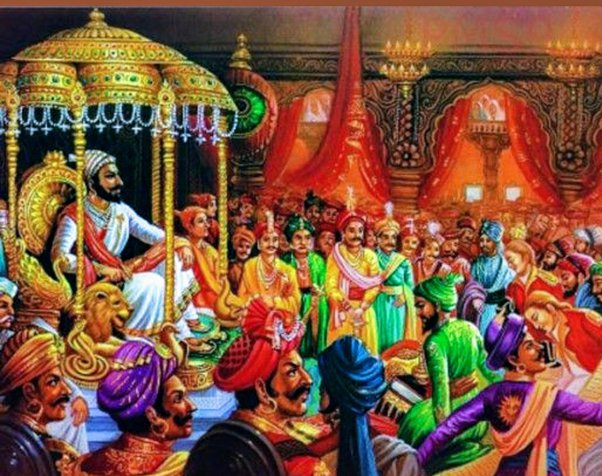
At 16, Shivaji captured Torna Fort during Bijapur’s turmoil, claiming its treasure. Over two years, he seized forts near Pune and expanded control eastward. Using Torna’s treasure, he built Rajgad Fort, his government’s seat for over a decade. After this, Shivaji Maharaj turned west to the Konkan and took possession of the important town of Kalyan. Noticing these events, the Bijapur government decided to act. Maratha Sardar Baji Ghorpade, under Bijapur’s orders, imprisoned Shahaji on July 25, 1648, to quell Shivaji.
Shahaji’s release in 1649 significantly bolstered Adilshah’s control in Karnataka. From 1649 to 1655, Shivaji focused on consolidating his gains instead of expanding further. However, after Shahaji’s release, Shivaji resumed his raiding activities. In 1656 he controversially killed Chandra Rao More, seized the Javali valley, and extended his reach into south and southwest Maharashtra. At this time, numerous influential families served Bijapur’s Adilshahi, often holding Deshmukhi rights. To subdue them, Shivaji employed a combination of strategies. This approach included forming alliances, engaging in direct dealings with Patils, and using forceful measures.
Despite Shahaji’s ambivalence toward his son’s actions, he actively disavowed Shivaji’s rebellious activities. He even instructed the Bijapuris to handle him as they deemed appropriate. Shahaji’s life ended around 1664–1665 in a hunting accident.
COMBAT WITH AFZAL KHAN
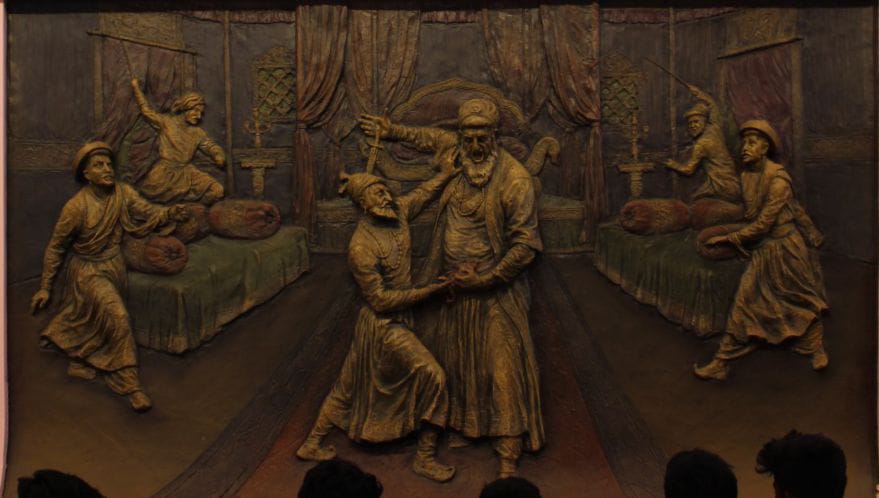
The Bijapur Sultanate, angered by Shivaji’s victories, saw Shahaji denouncing his son’s actions. After a peace treaty with the Mughals, Bijapur focused on Shivaji. In 1657, the sultan sent Afzal Khan to capture Shivaji, desecrating holy sites before engaging.
Pursued by Bijapuri forces, Shivaji retreated to Pratapgad fort, where many of his colleagues pressed him to surrender. The forces reached a stalemate, with Shivaji unable to break the siege and Afzal Khan lacking siege equipment to take the fort. After two months, Afzal Khan proposed a private meeting outside the fort.
The meeting took place in a hut near Pratapgad fort on November 10, 1659. Armed with only a sword and accompanied by just one follower, both leaders came together. Given his suspicions of Afzal Khan, Shivaji wore armour beneath his clothes, concealed a metal “tiger claw” on his left arm, and held a dagger in his right hand. Although the exact events remain uncertain, Maratha legends suggest that Shivaji killed Khan in a physical struggle. Following this, he signalled his troops to attack the Bijapur army with a cannon shot.
In the subsequent Battle of Pratapgarh, Shivaji’s forces decisively defeated the Bijapur Sultanate’s army. This victory led to the death of over 3,000 Bijapuri soldiers and the capture of several high-ranking prisoners. Shivaji then held a grand review below Pratapgarh, releasing the captured enemy soldiers with provisions and gifts to reward the valour of his Maratha troops.
SIEGE OF PANHALA
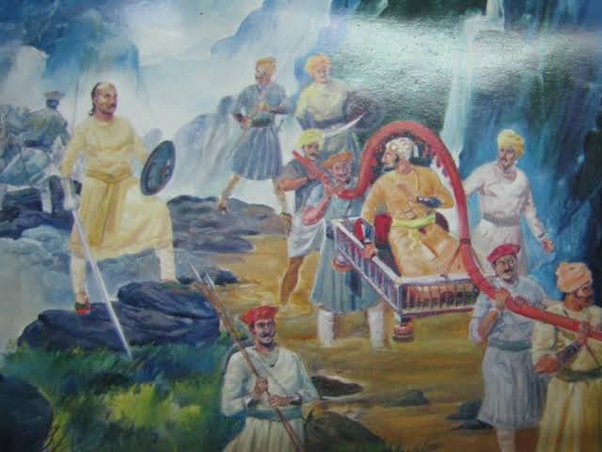
Having defeated the Bijapuri forces sent against him, Shivaji and his army marched towards the Konkan coast and Kolhapur, seizing Panhala fort, and defeating Bijapuri forces sent against them, under Rustam Zaman and Fazl Khan, in 1659. In 1660, Adilshah dispatched his general Siddi Jauhar to attack Shivaji’s southern border, while the Mughals planned a northern assault. Meanwhile, Shivaji stationed himself at Panhala fort. Consequently, Siddi Jauhar’s army besieged Panhala, cutting off supply routes. Amidst the bombardment, Siddi Jauhar procured grenades from the English at Rajapur, and enlisted English artillerymen, flying their flag. This perceived betrayal incensed Shivaji, prompting a December retaliation by plundering the English factory at Rajapur and capturing four owners, imprisoning them until mid-1663.
After enduring a lengthy siege, Shivaji negotiated the surrender of the fort to Siddi Jauhar on September 22, 1660, before retreating to Vishalgad. Nevertheless, he would later reclaim Panhala in 1673. During this period, Adilshah ordered Siddi Jauhar to assault Shivaji’s southern border, while the Mughals planned an attack from the north. Consequently, Shivaji positioned himself at Panhala fort, where Siddi Jauhar’s army laid siege and severed supply routes.
Meanwhile, during the blockade, Siddi Jauhar acquired grenades from the English at Rajapur and enlisted English artillerymen. In response, Shivaji retaliated in December by raiding the English factory, capturing four owners, and holding them until mid-1663.
BATTLE OF PAVAN KHIND
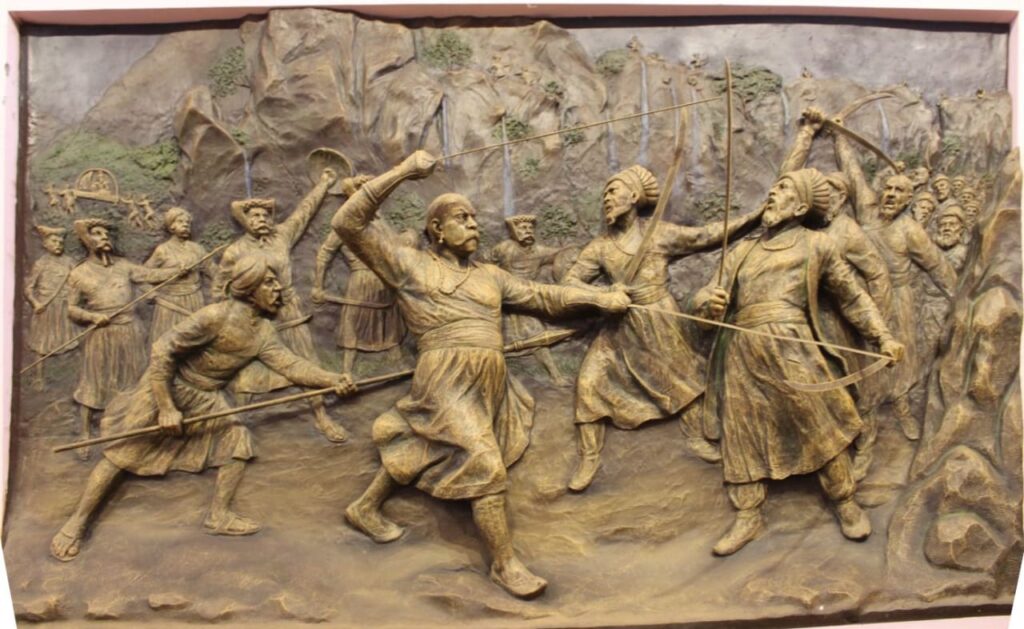
Shivaji escaped from Panhala by cover of night, and as he was pursued by the enemy cavalry, his Maratha Sardar Baji Prabhu Deshpande of Bandal Deshmukh, along with 300 soldiers, volunteered to fight to the death to hold back the enemy at Ghod Khind (“horse ravine”) to give Shivaji and the rest of the army a chance to reach the safety of the Vishalgad fort.
In the ensuing Battle of Pavan Khind, the smaller Maratha force held back the larger enemy to buy time for Shivaji to escape. Baji Prabhu Deshpande was wounded but continued to fight until he heard the sound of cannon fire from Vishalgad, signalling Shivaji had safely reached the fort, on the evening of 13 July 1660. Ghod Khind (khind meaning “a narrow mountain pass”) was later renamed Paavan Khind (“sacred pass”) in honour of Bajiprabhu Deshpande, Shibosingh Jadhav, Fuloji, and all other soldiers who fought there.
CONFLICTS WITH MUGHAL
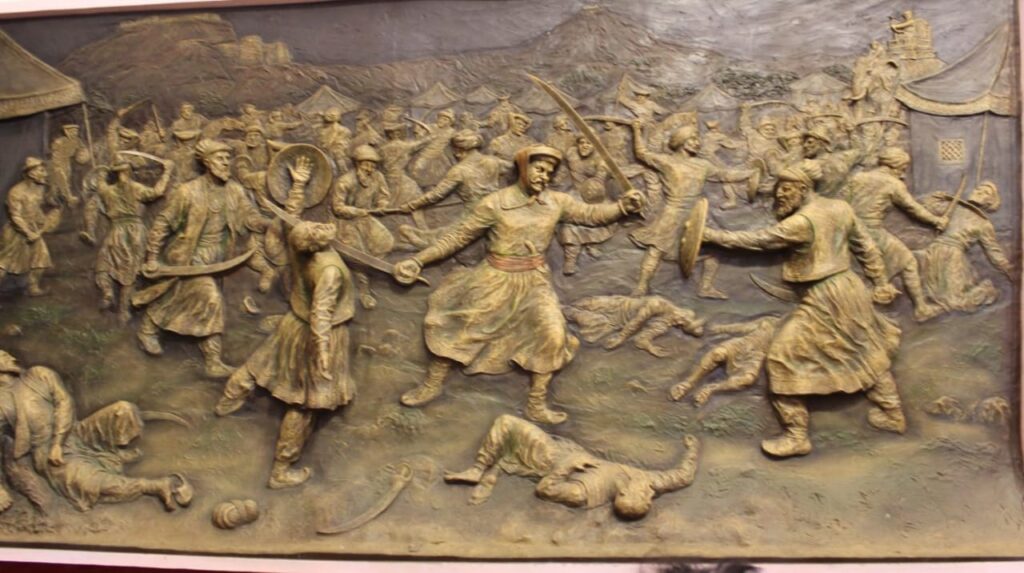
Until 1657, Shivaji maintained peaceful relations with the Mughal Empire. Shivaji offered his assistance to Aurangzeb, the son of the Mughal Emperor and viceroy of the Deccan, in conquering Bijapur, in return for formal recognition of his right to the Bijapuri forts and villages in his possession. Dissatisfied with the Mughal response, and receiving a better offer from Bijapur, he launched a raid into the Mughal Deccan. Shivaji’s confrontations with the Mughals began in March 1657 when two of his officers raided the Mughal territory near Ahmednagar. Subsequently, there were raids in Junnar, during which Shivaji carried off 300,000 hun in cash and 200 horses. In response, Aurangzeb sent Nasiri Khan, who defeated Shivaji’s forces at Ahmednagar. However, Aurangzeb’s countermeasures were interrupted by the rainy season, and his battles with his brothers over the Mughal throne succession after Shah Jahan fell ill.
ATTACKS ON SHAISTA KHAN & SURAT
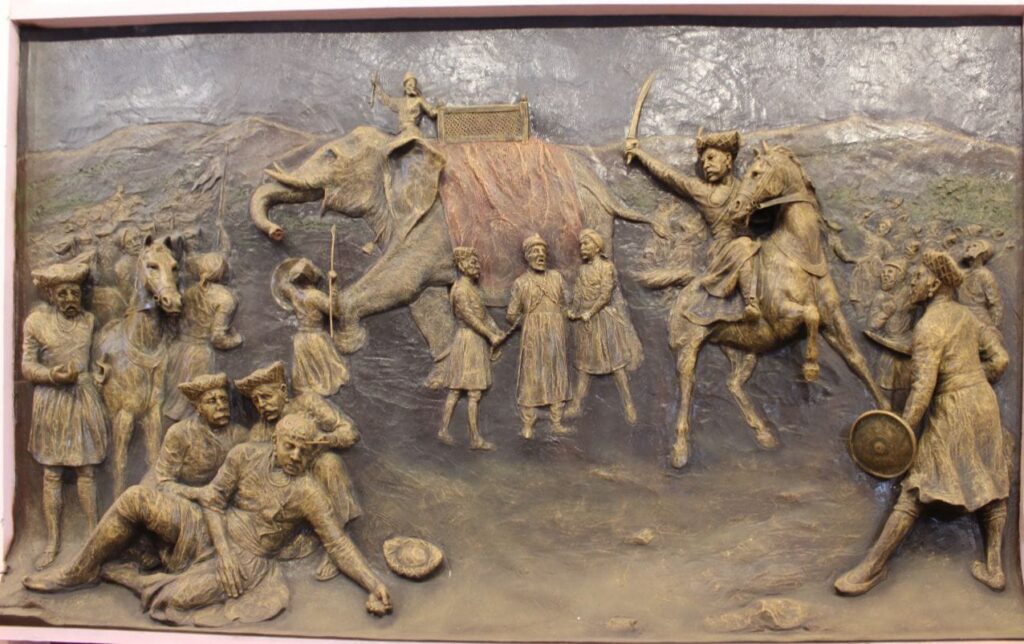
At the request of Badi Begum of Bijapur, Aurangzeb, now the Mughal emperor, dispatched his maternal uncle Shaista Khan in January 1660. Leading an army of over 150,000 along with a powerful artillery division, Shaista Khan was sent to attack Shivaji in collaboration with Bijapur’s army under Siddi Jauhar. Consequently, Shaista Khan, commanding a well-equipped and provisioned army of 80,000, captured Pune. He also seized the nearby fort of Chakan, laying siege for a month and a half before breaching the walls. After establishing his residence at Shivaji’s palace of Lal Mahal, tensions began to escalate.
On the night of April 5, 1663, Shivaji orchestrated a daring night attack on Shaista Khan’s camp. Leading 400 men, Shivaji stormed Shaista Khan’s mansion, breaking into Khan’s bedroom and inflicting wounds, resulting in Khan losing three fingers. Amid the ensuing chaos, Shaista Khan’s son, along with several wives, servants, and soldiers, were killed. Seeking refuge with the Mughal forces outside of Pune, Khan faced punishment from Aurangzeb for this embarrassment, which ultimately led to his transfer to Bengal.
In retaliation for Shaista Khan’s attacks, and to replenish his now-depleted treasury, in 1664 Shivaji sacked the port city of Surat, a wealthy Mughal trading centre. On 13 February 1665, he also conducted a naval raid on Portuguese-held Basrur in present-day Karnataka and gained a large plunder.
SHIVAJI MAHARAJ V/S AURANGZEB

Shivaji Maharaj and Aurangzeb clashed during the 17th century, representing a pivotal struggle for power, ideology, and regional autonomy in India. Shivaji Maharaj, from the Maratha clan, sought to establish an independent kingdom in western India emphasizing local governance and religious tolerance. His military strategies and administrative innovations challenged Mughal dominance under Aurangzeb, who pursued centralized rule and Islamic orthodoxy.
His decentralized governance model and respect for religious diversity contrasted sharply with Aurangzeb’s policies of religious imposition and centralization. Consequently, their conflict involved numerous military engagements, where Shivaji Maharaj employed guerrilla tactics to defend Maratha territories against Mughal expansion. Although they engaged in occasional negotiations, their fundamental ideological differences consistently perpetuated conflict. As a result, their clash significantly shaped Indian history.
Chhatrapati Shivaji Maharaj’s resistance against Aurangzeb’s centralizing policies and religious intolerance significantly influenced India’s socio-political landscape. His efforts contributed to the decline of Mughal influence in the Deccan and laid the groundwork for the rise of the Maratha Empire as a major regional power. The clash between Shivaji Maharaj and Aurangzeb highlights the complex dynamics of power, cultural diversity, and ideological confrontation that defined 17th-century India.
TREATY OF PURANDAR
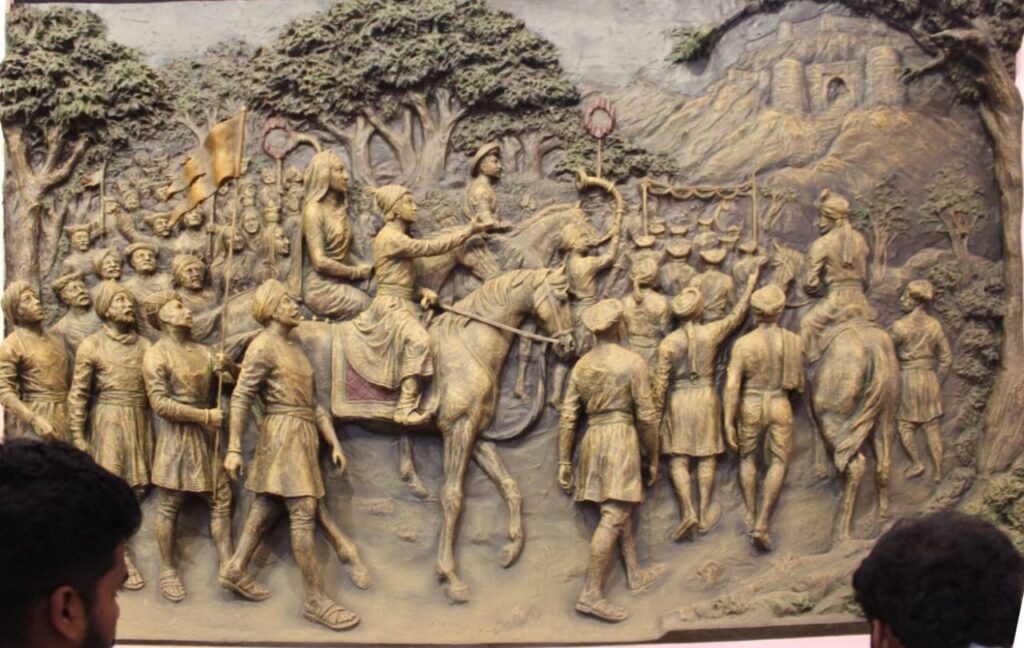
Infuriated by the attacks on Shaista Khan and Surat, Aurangzeb retaliated by sending the Rajput general Jai Singh I with an army numbering around 15,000 to defeat Shivaji. Throughout 1665, Jai Singh’s forces relentlessly pursued Shivaji, with their cavalry ravaging the countryside and besieging Shivaji’s forts. Amidst this relentless pressure, the Mughal commander successfully enticed several of Shivaji’s key commanders and many of his cavalrymen into Mughal service. By mid-1665, with the fortress at Purandar besieged and on the brink of capture, Shivaji was compelled to negotiate terms with Jai Singh.
In the Treaty of Purandar, signed by Shivaji and Jai Singh on 11 June 1665, Shivaji agreed to give up 23 of his forts, keeping 12 for himself, and pay compensation of 400,000 gold hun to the Mughals. Shivaji agreed to become a vassal of the Mughal empire, and to send his son Sambhaji, along with 5,000 horsemen, to fight for the Mughals in the Deccan, as a mansabdar.
Arrest in Agra and escape
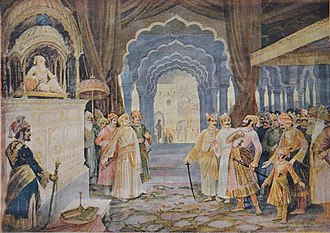
In 1666, Aurangzeb summoned Shivaji to Agra (although some sources suggest Delhi instead) along with his nine-year-old son, Sambhaji. Aurangzeb planned to send Shivaji to Kandahar, now in Afghanistan, to consolidate the Mughal empire’s northwestern frontier. However, on 12 May 1666, Shivaji found himself standing at court among relatively low-ranking nobles whom he had already defeated in battle. Offended by this insult, Shivaji stormed out and was immediately placed under house arrest. Consequently, Ram Singh, Jai Singh’s son, took responsibility for Shivaji and his son.
Under house arrest, Shivaji faced a perilous situation as Aurangzeb’s court debated whether to kill him or retain him in service. Meanwhile, Jai Singh, who had assured Shivaji of his safety, tried to influence Aurangzeb’s decision. In response, Shivaji devised a plan to escape. He sent most of his men back home and asked Ram Singh to retract his guarantees to the emperor for the safe custody of Shivaji and his son. Subsequently, Shivaji surrendered to the Mughal forces. Pretending to be ill, he began sending out large baskets filled with sweets to Brahmins and the poor as penance. On 17 August 1666, Shivaji cleverly hid in one of the large baskets while placing his son, Sambhaji, in another. This clever ruse enabled them to escape from Agra.
Reconquest

The peace between Shivaji and the Mughals lasted until 1670. At that point, Aurangzeb grew increasingly suspicious of Shivaji’s close ties with Mu’azzam. Aurangzeb feared that Mu’azzam might attempt to usurp his throne and might even be receiving bribes from Shivaji. Furthermore, Aurangzeb, who was preoccupied with fighting the Afghans, significantly reduced his army in the Deccan. As a result, many disbanded soldiers quickly joined the Maratha forces. Additionally, the Mughals seized Shivaji’s jagir of Berar to recover a loan from several years earlier. Consequently, Shivaji launched an offensive against the Mughals and, within four months, successfully reclaimed a major portion of the territories that had been surrendered.
Subsequently, in 1670, Shivaji attacked Surat once more. While the English and Dutch factories managed to repel his attack, Shivaji succeeded in sacking the city and plundering the goods of a Muslim prince who was returning from Mecca. Angered by these renewed assaults, the Mughals resumed hostilities. They sent a force under Daud Khan to intercept Shivaji on his return from Surat. However, this force was defeated in the Battle of Vani-Dindori, near present-day Nashik.
In October 1670, Shivaji’s forces began to harass the English in Bombay, as they had refused to sell him war materiel. Consequently, his forces blocked English woodcutting parties from leaving the city. By September 1671, Shivaji sent an ambassador to Bombay, again seeking material for his campaign against Danda-Rajpuri. Although the English were concerned about the potential advantages Shivaji might gain, they also sought compensation for the looting of their Rajapur factories. The English dispatched Lieutenant Stephen Ustick to negotiate, but discussions ultimately failed over the Rajapur indemnity. While some agreement on arms issues was reached in 1674, Shivaji never paid the indemnity before his death, and the factory at Rajapur dissolved by the end of 1682.
Battles of Umrani And Nesari
In 1674, Shivaji dispatched Prataprao Gujar, the Sarnaubat (commander-in-chief of the Maratha forces), to repel the invading force led by the Bijapur general, Bahlol Khan. As a result, Prataprao’s forces defeated and captured Bahlol Khan after successfully cutting off the enemy’s water supply by encircling a strategic lake. This tactical move compelled Bahlol Khan to seek peace. Nevertheless, despite Shivaji’s explicit warnings against doing so, Prataprao chose to release Bahlol Khan. Consequently, Bahlol Khan began preparing for a fresh invasion.
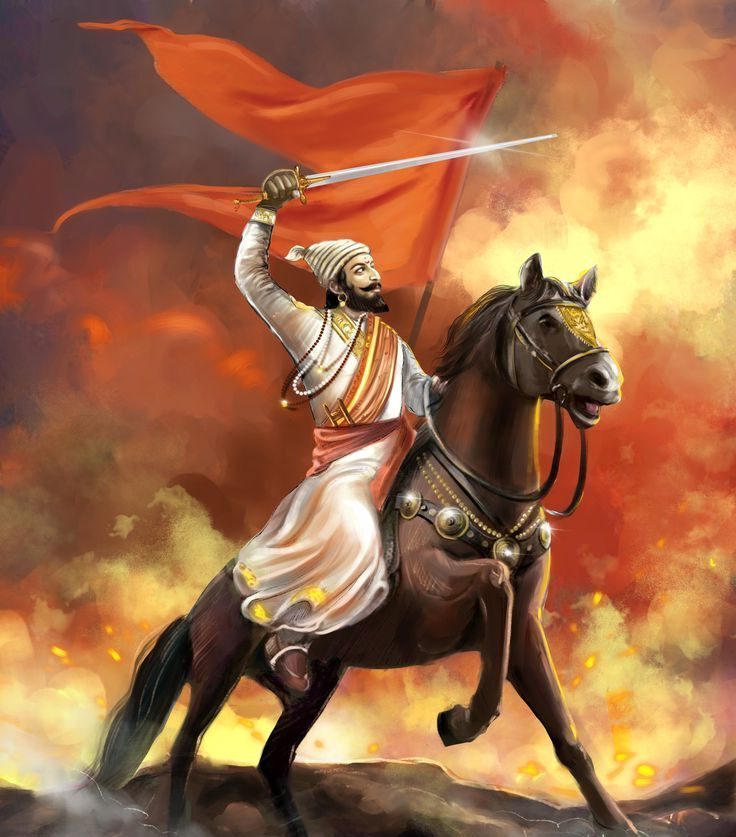
In response, Shivaji sent a letter to Prataprao, expressing his displeasure and refusing him an audience until Bahlol Khan was recaptured. Upset by this reprimand, Prataprao set out to find Bahlol Khan. He then attacked his position with only six horsemen, leaving his main force behind. Tragically, Prataprao was killed in combat. Upon hearing of Prataprao’s death, Shivaji was deeply grieved and arranged for his second son, Rajaram, to marry Prataprao’s daughter. Subsequently, Shivaji appointed Hambirrao Mohite as the new sarnaubat. In addition, Hiroji Indulkar completed the construction of Raigad Fort, which subsequently became the capital of the nascent Maratha kingdom.
Chhatrapati Shivaji Maharaj Coronation
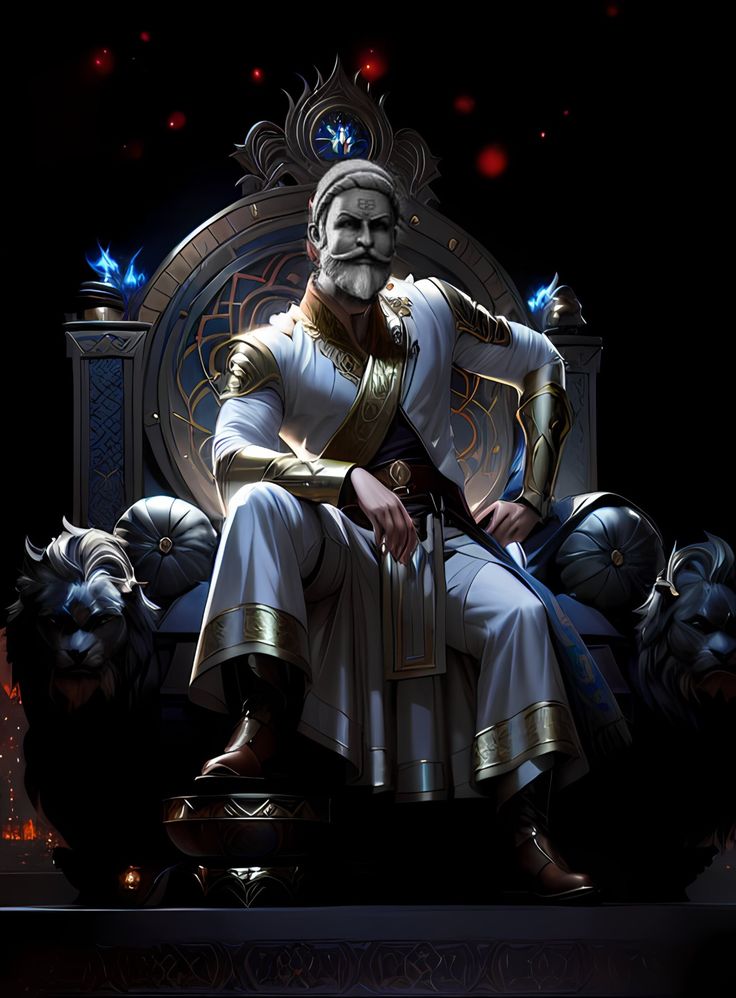
Shivaji gained significant lands and wealth through his campaigns; however, without a formal title, he remained technically a Mughal zamindar or the son of a Bijapuri Jagirdar. To legitimize his rule and prevent challenges from other Maratha leaders, Shivaji realized that a royal title was essential. Additionally, such a title would provide Hindu Marathis with a fellow Hindu sovereign in a region otherwise ruled by Muslims.
In 1673, Shivaji began preparing for his coronation, but controversies delayed it for nearly a year. The Brahmins in his court refused to crown him, insisting that only Kshatriyas could be kings.
As Shivaji descended from village headmen, they classified him as a Maratha, not a Kshatriya. To resolve this, Shivaji summoned Gaga Bhatt, a Varanasi pandit, who linked him to the Kshatriya Sisodias. To solidify this status, Shivaji underwent a sacred thread ceremony and remarried his wives under Vedic rites. However, historical evidence suggests his Kshatriya claim might have been weak.
On 28 May 1674, Shivaji performed penance for his ancestors’ failure to observe Kshatriya rites and subsequently received the sacred thread. Yet, under pressure from other Brahmins, Gaga Bhatt initiated Shivaji into a modified twice-born life. The following day, Shivaji sought to atone for his sins, including those committed during his raids, by generously distributing wealth among the Brahmins.
Finally, on 6 June 1674, Shivaji crowned himself king of the Maratha Empire (Hindavi Swaraj) at Raigad fort, with fifty thousand people in attendance. He assumed the titles Shakakarta, Chhatrapati, Haindava Dharmodhhaarak, and Kshatriya Kulavantas. After his mother’s death on 18 June 1674, Shivaji decided to conduct a second coronation on 24 September 1674, thereby addressing concerns about the original ceremony.
Conquest In Southern India
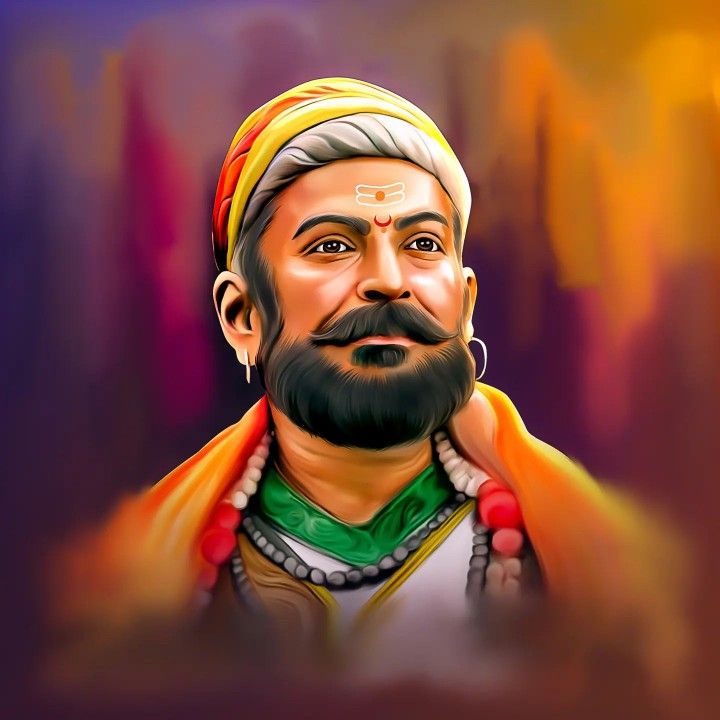
Starting in 1674, the Marathas launched an aggressive campaign, first raiding Khandesh in October, then capturing Bijapuri Ponda in April 1675, followed by Karwar and Kolhapur. In November, the Maratha navy clashed with the Siddis of Janjira but failed to dislodge them. After recovering from illness and seizing the opportunity created by a civil war in Bijapur, Shivaji raided Athani in April 1676.
As Shivaji prepared for his expedition, he appealed to Deccani patriotism, urging the protection of Southern India from outsiders. This gained some support, and in 1677, Shivaji visited Hyderabad and formed a treaty with the Qutubshah of Golkonda, who agreed to join forces against the Mughals. Shivaji then invaded Karnataka with 30,000 cavalry and 40,000 infantry, backed by Golkonda artillery. Moving south, he captured the forts of Vellore and Gingee, the latter becoming the Maratha capital under his son, Rajaram I.
Shivaji also sought to reconcile with his half-brother Venkoji, who ruled Thanjavur. However, their negotiations failed, leading Shivaji to defeat Venkoji’s army on 26 November 1677, seizing most of his possessions. Venkoji’s wife, Dipa Bai, later convinced Shivaji to return many of these properties to her and her descendants. Shivaji agreed, with Venkoji consenting to conditions for administering the territories and maintaining Shahaji’s tomb (samadhi).
